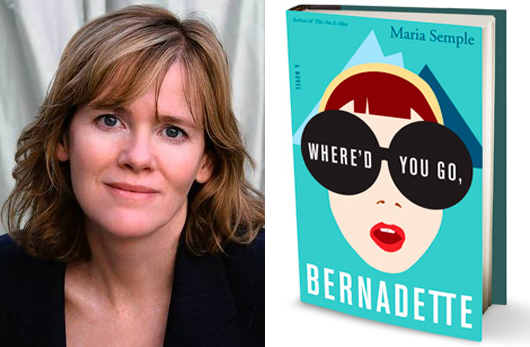New York Times reviewer Janet Maslin calls Maria Semple’s new book, Where’d You Go, Bernadette, a “sparkling novel” full of “free-range hilarity.” Maslin continues, “The tightly constructed Where’d You Go, Bernadette is written in many formats — emails, letters, FBI documents, correspondence with a psychiatrist and even an emergency-room bill for a run-in between Bernadette and Audrey. Yet these pieces are strung together so wittily that Ms. Semple’s storytelling is always front and center.”
One of the formats you might find most amusing: on page 156, character Elgin Branch gives a TED Talk. And the fast-paced chapter describes a TED Conference in such detail that it left many in the TED office wondering how Semple — a writer for the sadly defunct TV show Arrested Development — knew so much.
And so … we asked her. Below, a Q&A with Maria, who happened to attend the TED Conference in Monterey in 2007 and again in 2008.
For people who haven’t read the book yet, who is the character giving a TED Talk and what is his talk about?
Elgin Branch is a Microsoft engineer who unveils a project called Samantha 2, the latest breakthrough in the field of brain-computer interface. Samantha 2 is a transmitter that looks like a Band-Aid. When Elgin sticks it on his forehead, it intercepts his brain waves and diverts them to a computer that acts on his thoughts. He demonstrates this during his TED Talk by reclining in a chair, hands at his sides, and being able to switch channels on a TV and write an email on the big overhead screen just by thinking about it.
Your description of the TED Conference is so detailed! Have you ever been to one?
I attended TED in 2007 and 2008, the last two years the conference was held in Monterey. I found myself especially interested in the people-watching, the stylish lounges full of crazy stuff, and the attendees’ strong opinions about the presenters — all the stuff you don’t see in the TED Talks.
Why did it feel right to include TED in your book?
When I came back from my first TED, very few people knew what it was. But around the time I was sitting down to write Where’d You Go, Bernadette, in 2010, TED was exploding. Every day, it seemed, friends were emailing me links to TED Talks. People were breathlessly mentioning people they knew who had given TED Talks. It had become cultural currency, which seemed kind of funny, and something I could use.
I knew my character, Elgin, was a higher-up at Microsoft. And I remembered a chance encounter at my first TED: when I was checking into the hotel with my boyfriend, George Meyer, and our 2-year-old daughter, we met a friendly, attractive couple with a child. The four of us bonded and shared a laugh over the inappropriateness of bringing little kids to TED. The next day, the father, Blaise Agüera y Arcas, gave a mind-blowing 5-minute talk on Microsoft’s Photosynth. Not only was the technology a stunner, but Blaise himself, clearly a genius, was utterly relaxed and charming. So I used him as an inspiration. (Don’t worry! He knows and approves.)
In Where’d You Go, Bernadette, I have someone live-blog Elgin’s TED Talk. I thought it would be even more fun to throw in some authentic details about what it’s like to attend the actual conference: the gift bags, the free Vosges caramels (my personal favorite), the camaraderie, the dizzying feeling of being part of something important, the intermission scuttlebutt, the technical glitches, the celebrity-spotting. I’m only sorry I wasn’t able to include Tom Rielly’s end-of-conference recap. Five years later, I’m still quoting jokes he came up with on the fly.
What are your three favorite TEDTalks?
I have to go old school. Jeff Han’s touchscreen breakthrough. Ken Robinson’s 2006 talk on how schools kill creativity. And of course, Blaise’s Photosynth talk and demonstration.
If you had to give a TED Talk — say, tomorrow — what idea would you want to spread?
If you’re an artist and you’re on Twitter, you are doomed to mediocrity. Creating art is painful. It takes time, practice and the courage to stand alone. Twitter, on the other hand, feeds on impulse and instant gratification; it requires and reinforces an attention-seeking mindset; it puts you in dialogue with strangers whose opinions you are constantly monitoring; it’s a slow leak in your creative reservoir. So the choice is yours: serious artist or Tweeter. I know this is an unpopular opinion right now and many people will object. Luckily, I’m not on Twitter, so I’ll never hear about it!

Comments (7)
Pingback: Christmas Break Reading | Beauté Simple
Pingback: Readers’ Advisory 2: Where’d You Go, Bernadette? Maria Semple | Tattooed Librarian Lush
Pingback: BJ Novak on his short story, “The Impatient Billionaire and the Mirror for the Earth,” which pivots on a misunderstood TED Talk | Health & Wellness Chicago
Pingback: Where’d You Go, Bernadette? and TED Talks | SFUHS Reads
Pingback: Two new additions to the TEDGlobal 2013 program: Blaise Agüera y Arcas and George Monbiot | Krantenkoppen Tech
Pingback: Two new additions to the TEDGlobal 2013 program: Blaise Agüera y Arcas and George Monbiot | BizBox B2B Social Site
Pingback: Episode No. 68: Maria Semple, Novelist « All In A Day's Work